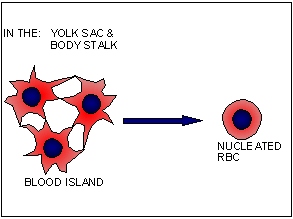
Thus, the developmental pattern, rather than beginning from the formation of one central vessel and spreading outward, occurs in many regions simultaneously with vessels later joining together. Vascular tubes also develop on the blood islands, and they eventually connect to one another as well as to the developing, tubular heart. While the vessels are developing, the pluripotent stem cells begin to form the blood. Surrounding mesenchymal cells give rise to the smooth muscle and connective tissue layers of the vessels. The endothelial lining of the vessels arise from the angioblasts within these islands. Spaces appear on the blood islands that develop into vessel lumens. (Seek additional content for more detail on fetal development and circulation.) Together, these cells form masses known as blood islands scattered throughout the embryonic disc. These in turn differentiate into angioblasts, which give rise to the blood vessels and pluripotent stem cells, which differentiate into the formed elements of blood. The precursor cells are known as hemangioblasts. During those first few weeks, blood vessels begin to form from the embryonic mesoderm. You will learn more about the formation and function of these early structures when you study the chapter on development. Development of these circulatory elements within the embryo itself begins approximately 2 days later. Blood cells and vessel production in structures outside the embryo proper called the yolk sac, chorion, and connecting stalk begin about 15 to 16 days following fertilization. It is critical to the survival of the developing human that the circulatory system forms early to supply the growing tissue with nutrients and gases, and to remove waste products.

Circulation patterns are clearly established by the fourth week of embryonic life. In a developing embryo,the heart has developed enough by day 21 post-fertilization to begin beating. Describe the development of blood vessels.By the end of this section, you will be able to:


 0 kommentar(er)
0 kommentar(er)
